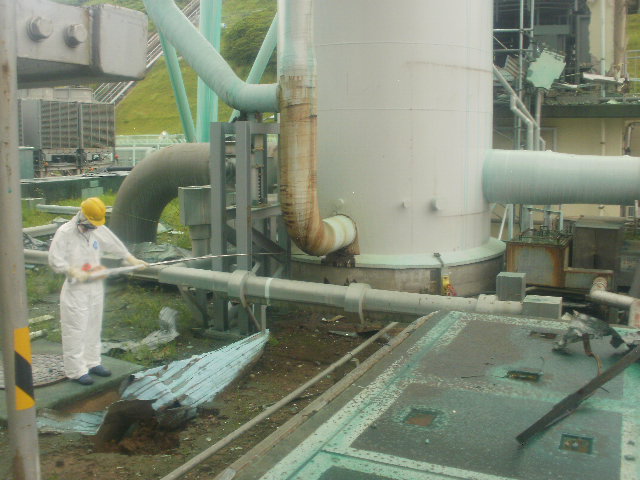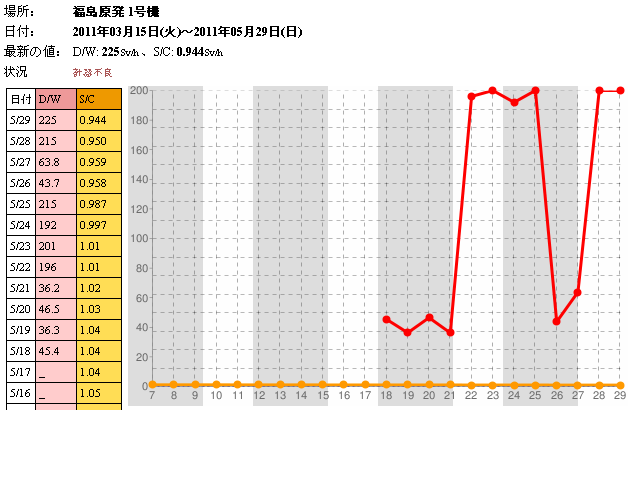On July 31, 2011 Tepco detected a radioactive hotspot at the base of an exhaust stack serving units 1 and 2 of Fukushima Daiichi. The following day, a measurement showed the activity to be more than 10 Sv/h (10,000 mSv/h), the highest measured in any accessible part of the wrecked nuclear power station so far (see “The worst hot spot in Fukushima“).
The high activity is assumed to date from attempts at venting the containment of unit 1 on March 12, after it had suffered core damage the previous evening. The venting, necessary to prevent the containment from bursting from excessive pressure, used a so called “hardened vent path” installed by Tepco between 1999 and 2001, following similar upgrades in the US after the Three Mile Island accident.
The reactors have filter system known as the “Standby Gas Treatment System” (SGTS), located on the second floor of the reactor building right next to the turbine hall, but the SGTS doesn’t work without electricity, i.e. the condition that triggered core damage in Fukushima Daiichi. Also, gas from the containment is released at high pressure, which would overwhelm the SGTS.
Therefore the gas is released untreated. Via a strong steel pipe it flows directly into the base of an over 100 m tall exhaust stack. High altitude winds carry it away from the plant. The only filtering that has taken place before than is by water in the pressure suppression pool at the bottom of the containment, through which any gas releases from the reactor pressure vessel are forced to bubble. As the high radioactivity level around the stack demonstrates some 5 months later, there is still plenty of activity left in the gas after that “wet scrubbing”.
It didn’t have to be that way. First of all, if Tepco had built the reactors at a higher location or surrounded them with a sea wall to protect them from a 14 meter high tsunami, there probably would not have been a total station blackout and hence a failure of the residual heat removal system (RHR). The cores wouldn’t have melted. It has long been known that the relatively small Mark 1 containment of these Boiler Water Reactors (BWRs) have problems dealing with vast volumes of hydrogen gas produced when core damage occurs. There was no way to make the containment bigger, short of decommissioning the old reactors and building new ones, which would have cost a lot of money. But that wasn’t the only option.
In 1981, Sweden came up with the FILTRA system for their Barsebäck nuclear power station, which consisted of two BWRs similar in size and functionality to the units in Fukushima. Construction of Barsebäck had started in 1969, only two years after the first unit in Fukushima. It was located about 500 km south of the Swedish capital of Stockholm, but only 20 km from the Danish capital of Copenhagen. The Copenhagen metropolitan region is home to about 1.9 million people in Denmark and South Sweden is also one of the most densely populated parts of the country.
The FILTRA system consists of concrete pipes or rock tunnels filled with gravel, through which the released gas must flow. It gives off heat to some 10,000 m3 of rock, which condenses steam and radioactive fission products, which collect at the bottom of the gravel chambers. After the gas has cooled it is sent through sand or water for further filtration. Only then is it released in the stack. The system is simple and robust enough to cope with high pressure and temperatures. Since it doesn’t use any high technology it was relatively cheap to build.
There was plenty of space available at Fukushima. The Swedish system was no secret. Here is the 30 year old report that discussed its details. Why did Tepco not build a filter system like that, to be shared among its 6 units at Fukushima Daichi? By building the hardened vent path, it already admitted to the possibility of a core meltdown, so why not make sure the venting could be cleaned up? Perhaps Tepco didn’t want to spend more money on safety than it absolutely had to. Perhaps it was also because the Swedish reactors were designed by Asea-Atom AB, whereas the Fukushima design was by GE. Whatever the reason, the technology to protect the people of Japan in a nuclear accident has been available for three decades and Tepco chose not to use it.


